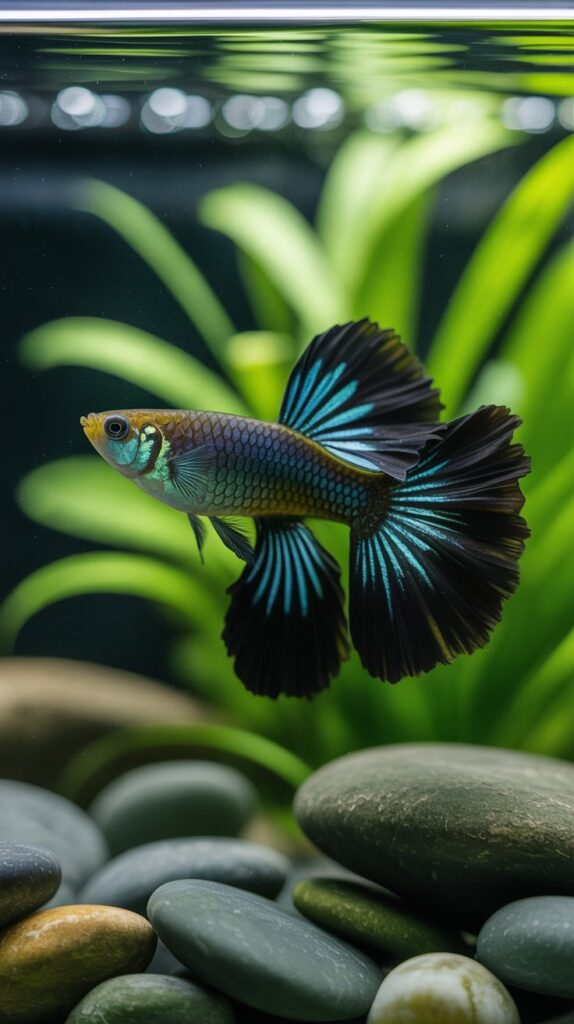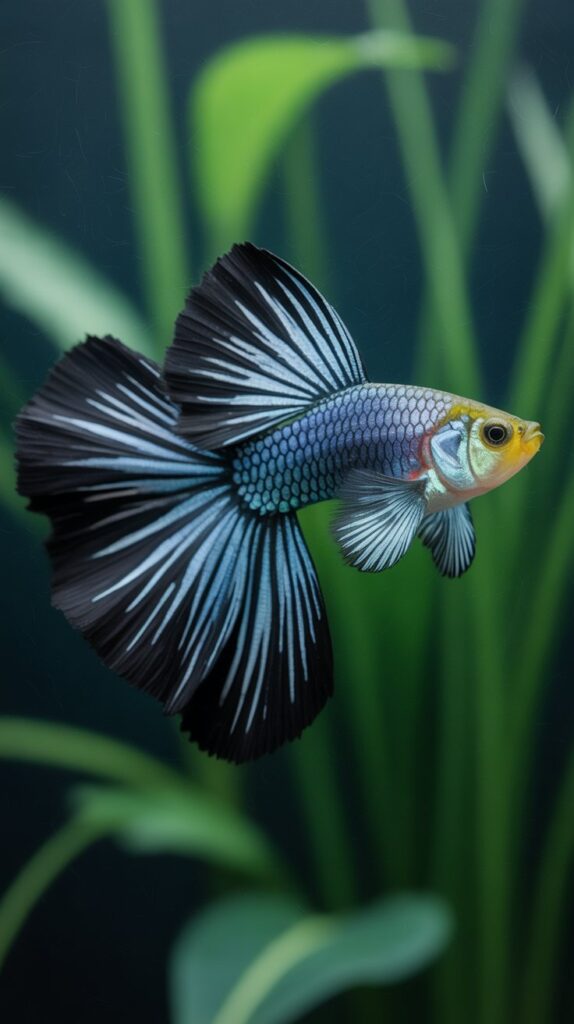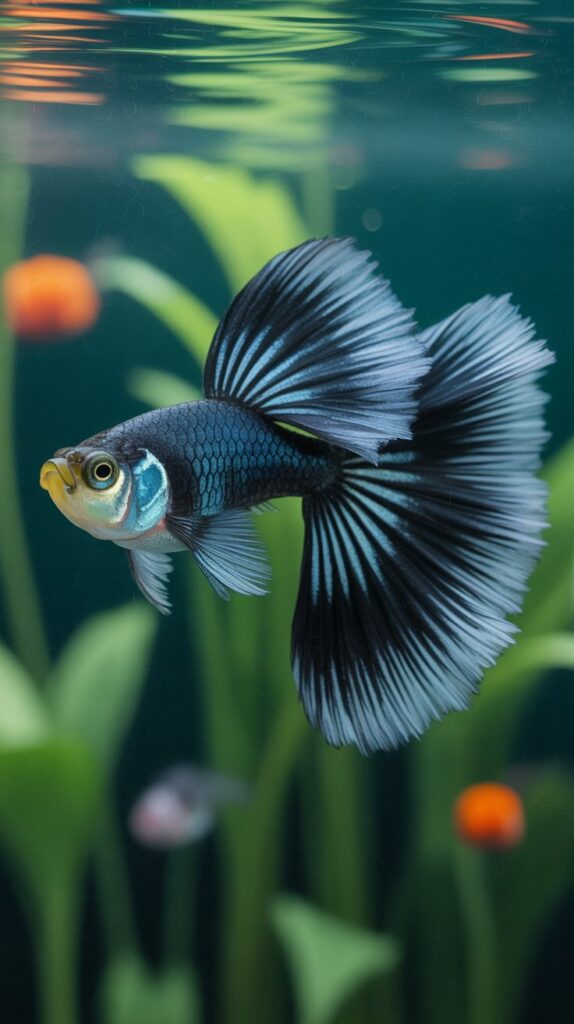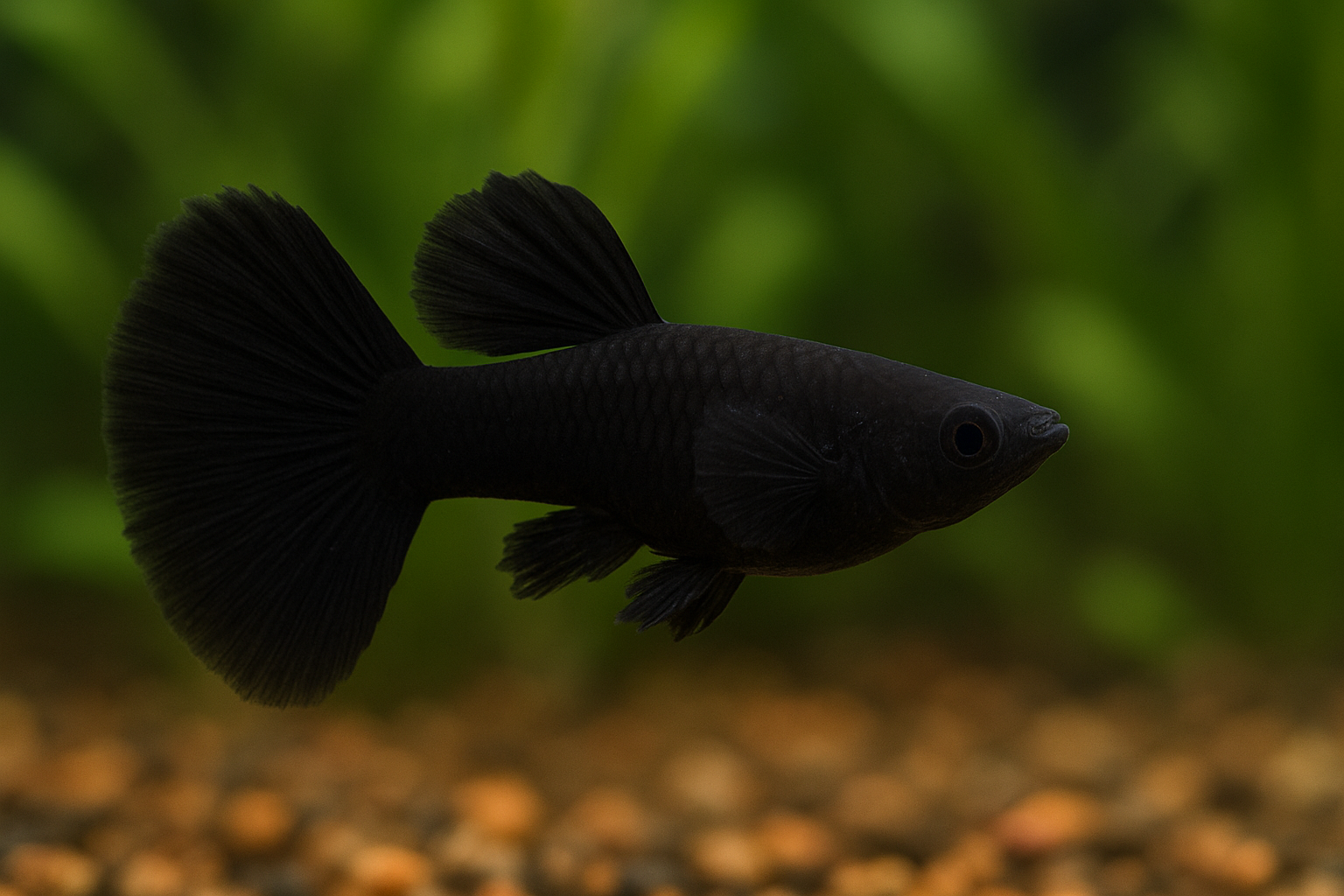The Full Black Guppy is one of the most stunning and sought-after varieties in the guppy world. Known for its deep, velvety black coloration that covers its entire body and fins, this fish is a true statement piece in any aquarium. Its elegance, graceful swimming patterns, and ease of care make it a favorite among both beginners and professional breeders.
In the world of ornamental fish, color intensity and uniformity are prized qualities, and the Full Black Guppy stands out for its solid pigmentation without patches or fading. Whether kept in a single-species tank or as part of a peaceful community aquarium, these guppies add a dramatic touch that’s hard to miss.
Origin and History
Guppies (Poecilia reticulata) are native to South America, specifically in regions of Venezuela, Brazil, and Guyana. Over decades, selective breeding has produced a variety of color morphs, patterns, and fin shapes.

The Full Black Guppy is not a naturally occurring variety—it’s the result of selective breeding programs aimed at achieving the deepest black possible without any metallic or iridescent interruptions. Breeders have refined this strain over many generations to maintain color stability, health, and fertility.
Physical Appearance
The beauty of the Full Black Guppy lies in its uniform deep black pigmentation from head to tail.
Key Features:
- Body Color: Solid, deep black with no other colors or patterns.
- Fins: Fully black and flowing, often with longer fin varieties such as delta tail, veil tail, or lyretail.
- Size: Males typically grow up to 1.5–1.8 inches, while females are larger, reaching 2–2.5 inches.
- Eyes: Usually dark, complementing their body color.
- Shape Variations: Available in various fin shapes—triangle tail, round tail, swordtail, and more.
Sexual Dimorphism
Full Black Guppies show clear differences between males and females:
- Males: Smaller, slimmer, with more vibrant black coloration and larger, more ornate tails.
- Females: Larger, rounder bodies, slightly duller black due to carrying fry, and shorter tails.
Temperament and Behavior

Full Black Guppies are peaceful and active swimmers. They’re community-friendly and rarely show aggression, making them ideal tank mates for other peaceful species like tetras, mollies, platies, and corydoras.
They’re also curious and playful, often exploring all tank levels, especially the middle and top.
Tank Setup for Full Black Guppy
1. Tank Size
While guppies can survive in smaller tanks, a minimum of 10 gallons is recommended for a small group. Larger tanks (20–30 gallons) provide more space for swimming and breeding.
2. Water Parameters
Maintaining optimal water conditions is crucial for color vibrancy and health:
- Temperature: 74–82°F (23–28°C)
- pH: 6.8–7.8
- Hardness: 8–12 dGH
- Ammonia/Nitrite: 0 ppm
- Nitrate: <20 ppm
3. Filtration
A gentle filter (like a sponge filter) is best to avoid damaging delicate fins.
4. Lighting
Moderate lighting helps showcase the deep black color without causing stress.
5. Substrate and Decor
- Substrate: Dark sand or gravel enhances their color.
- Plants: Live plants such as Java moss, hornwort, and anubias provide hiding spots and help with water quality.
- Hiding Spaces: Small caves or driftwood for females to hide during pregnancy.
Diet and Feeding

Full Black Guppies are omnivores and thrive on a varied diet:
Recommended Foods:
- High-quality flakes (designed for guppies or tropical fish)
- Pellets (micro or slow-sinking types)
- Live/Frozen Foods: Brine shrimp, daphnia, bloodworms
- Vegetable Matter: Blanched spinach, cucumber, zucchini
Feeding Tip: Offer small portions 2–3 times daily to prevent overfeeding and water pollution.
Breeding Full Black Guppy
Breeding guppies, especially Full Black varieties, is relatively easy but requires attention to strain purity.
Breeding Steps:
- Select Healthy Parents: Choose the darkest, healthiest males and females.
- Breeding Tank: 5–10 gallons with a sponge filter and dense plants for fry hiding.
- Pregnancy Duration: Around 21–30 days.
- Fry Care: Separate fry from adults immediately to prevent predation.
- Fry Diet: Crushed flakes, baby brine shrimp, microworms.
Note: To maintain the black intensity, avoid crossbreeding with other colors unless creating a new strain.
Common Health Issues
Like other guppies, Full Black Guppies are generally hardy but can be prone to:
- Ich (White Spot Disease)
- Fin Rot
- Velvet Disease
- Bacterial Infections
- Swim Bladder Disorder
Prevention Tips:
- Keep water clean and stable.
- Quarantine new fish before adding them to the main tank.
- Avoid overfeeding.
Price and Availability

Full Black Guppies are moderately priced compared to rare strains. Prices range from $3 to $10 per fish, depending on size, quality, and fin type. High-grade show guppies can cost more.
They are widely available in:
- Local pet stores
- Online fish retailers
- Breeders specializing in guppy strains
Why Choose Full Black Guppy?
- Stunning visual appeal
- Peaceful temperament
- Beginner-friendly care
- Easy breeding
- Great for aquascaping with contrast colors
Tips for Maintaining Deep Black Color
- Provide a balanced diet with high protein content.
- Avoid keeping them in overly bright light.
- Maintain stable water parameters.
- Use dark backgrounds and substrates.
- Selective breeding with only the darkest individuals.
Conclusion
The Full Black Guppy is a captivating freshwater fish that offers elegance, charm, and easy care for hobbyists of all levels. Its deep black coloration adds a unique visual dimension to any aquarium, and with the right care, these fish will thrive and reproduce readily.
Whether you’re a casual fish keeper or a dedicated breeder, the Full Black Guppy is a beautiful, hardy, and rewarding addition to your collection.
FAQs About Full Black Guppy
Q1: How long do Full Black Guppies live?
A: With proper care, they typically live 2–3 years, but some can live up to 4 years in optimal conditions.
Q2: Can I keep Full Black Guppies with other fish?
A: Yes, they’re peaceful and do well with other non-aggressive species like tetras, mollies, and corydoras.
Q3: Why is my Full Black Guppy fading in color?
A: Color loss can be caused by poor diet, stress, illness, or bright lighting. Ensure proper nutrition and stable water conditions.
Q4: How many Full Black Guppies should I keep together?
A: A group of at least 6 guppies is ideal for social interaction and reduced stress.
Q5: Are Full Black Guppies good for beginners?
A: Absolutely! They are hardy, adaptable, and easy to breed, making them perfect for new aquarists.

